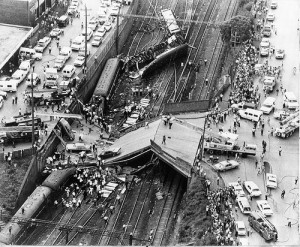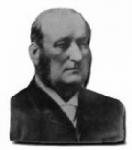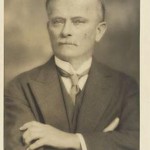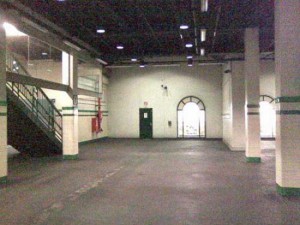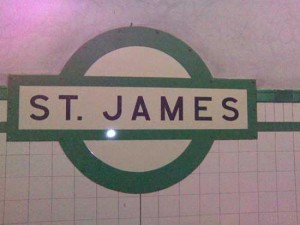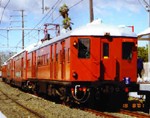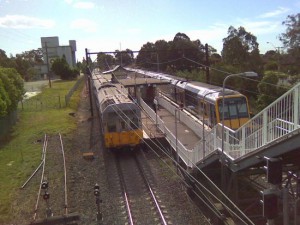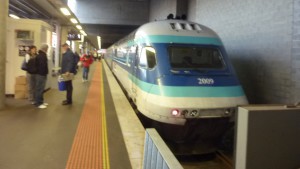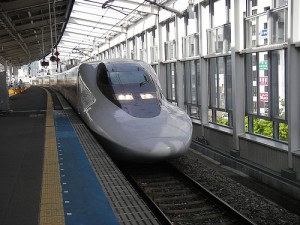
SAY YES TO HEAVY RAIL: SAY NO TO METRO RAIL
Victor P Taffa
Country New South Wales had many Branch Railway Lines closed and replaced by more costly bus services. The Newcastle Line is next and it would seem that this policy is driven by Baron Richard Beeching in the U.K. His policy was popularly known as the ‘Beeching Axe’. As Australia is the largest island Continent in the world, the Beeching Policy of Railway Line Closures is totally inappropriate for our needs.
Country New South Wales needs modern railway lines that are linked to other communities. New and innovative services that include Restaurant/ Lounge Carriages can transform rural communities and reduce road toll statistics.
Granville Rail Disaster
Having Metro Rail rammed down our throats is an insult to the 83 People who were killed in the Granville Rail Disaster on 18 January 1977. 210 People were also injured.
On the morning of 18 January 1977 the 6.09am train left Mount Victoria on its usual trip to Sydney. As the 8 Car 6.09 got closer to Sydney the train would be packed with commuters. As the train approached the Bold Street overpass at Granville the train jumped off the tracks and collided into the stanchions of the bridge. Half the concrete bridge collapsed onto the second half of carriage 3 and the first half of carriage 4. The roof of carriage 1 sheared off. Carriages 2 and 5-8 were left upright and intact.
The Coroner found that the permanent way (Tracks) were worn and the rails spread due to the rails not being fastened. Years of neglect of the Rail Network was found to be the cause of the Rail Disaster and excessive weight of the overpass contributed to the number of deaths. The Coroner cleared the train driver of any possible wrongdoing.
The Beeching Axe
Richard Beeching, Baron Beeching (21 April 1913 – 23 March 1985), commonly known as Dr. Beeching, was chairman of British Railways and a physicist and engineer. He became a household name in Britain in the early 1960s for his report ‘The Reshaping of British Railways’, commonly referred to as ‘The Beeching Report’, which led to far-reaching changes in the railway network, popularly known as the Beeching Axe.
As a result of the report, just over 4,000 route miles were cut on cost and efficiency grounds, leaving Britain with 13,721 miles (22,082 km) of railway lines in 1966. A further 2,000 miles (3,200 km) were lost by the end of the 1960s.
The Beeching cuts (also Beeching Axe) refer to the reduction of route network and restructuring of the Railways in Great Britain outlined in two reports, The Reshaping of British Railways (1963) and The Development of the Major Railway Trunk Routes (1965), written by Dr Richard Beeching and published by the British Railways Board.
The first report identified 2,363 stations and 5,000 miles (8,000 km) of railway line for closure, 55% of stations and 30% of route miles, with an objective of stemming the large losses being incurred during a period of increasing competition from road transport; the second identified a small number of major routes for significant investment. The 1963 report also recommended some less well publicised changes, including a switch to containerisation for rail freight.
Protests resulted in the saving of some stations and lines, but the majority was closed as planned and Beeching’s name is to this day associated with the mass closure of railways and the loss of many local services in the period that followed. A number of these routes have since reopened, been incorporated into the National Cycle Network or used for road schemes; others were lost to construction or simply reverted to farm land.
The ‘Branch Lines Committee’ of the British Transport Commission (BTC) was formed in 1949 with a brief to close the least-used branch lines; 3,318 miles (5,340 km) of railway were closed between 1948 and 1962.
The Beeching Reports
The report ‘The Reshaping of British Railways’ (or Beeching I report) was published on 27 March 1963. Out of 18,000 miles (29,000 km) of railway, Beeching recommended that 6,000 miles (9,700 km)—mostly rural and industrial lines—should be closed entirely, and that some of the remaining lines should be kept open only for freight. A total of 2,363 stations were to close, including 435 already under threat, both on lines that were to close and on lines that were to remain open.
The Development of the Major Railway Trunk Routes (Beeching II)
On 16 February 1965, Beeching announced the second stage of his reorganisation of the railways in ‘The Development of the Major Railway Trunk Routes’. In this report he set out his conclusion that of the 7,500 miles (12,100 km) of trunk railway only 3,000 miles (4,800 km) “should be selected for future development” and invested in.
The Closures
Line closures, which had been running at about 150-300 mile per year between 1950 and 1961, peaked at 1,000 miles (1,600 km) in 1964 and had come to a virtual halt by the early 1970s.
One of the last major closures was the 98-mile long (158 km) Waverley Route between Carlisle, Hawick and Edinburgh in 1969; the re-opening of a 35-mile section of this line has been approved by the Scottish Parliament and passenger services are due to resume in 2014.
The Beeching Report remains controversial. Critics have accused Beeching of ignoring the social consequences of his proposals. There is little doubt that rail replacement bus services were rarely a success.
Heavy Railway Expansion For Sydney And New South Wales
The population of Sydney has grown 3 times the size of the Sydney Heavy Rail Network. In that time Roads, Schools and Hospitals have all been built. Over the years land is subdivided, new suburbs established and yet no new Railway Lines are built or old Branch Lines such as the Camden, Richmond-Kurrajong, Rogans Hill and Ropes Creek Lines are closed.
John Whitton
The first railway line that operated in New South Wales ran from Sydney to Parramatta on 26 September 1855. Services reached Albury on 3 February 1881.Other lines extended to Broken Hill on 15 July 1919 and Murwillumbah on 24 December 1894. The first electric train to operate in New South Wales ran from Sydney to Oatley on 1 March 1926.
Who was responsible for this development? Mr. John Whitton arrived in Sydney in December 1856. He was appointed Engineer-in-Chief of the New South Wales Railways and at the time there was only 37Km of completed railway. Upon retirement in 1890 there was 3,538 Km of completed railway. He is acknowledged as the ‘Father of the New South Wales Railways’.
John Whitton found in New South Wales 23 miles (37 km) of 4 ft 8½ ins (144 cm) gauge railway, 4 locomotives, 12 passenger carriages and 40 trucks. He reorganized accounting and costing and took charge of the rolling stock, line maintenance and workshop departments. He resisted Governor Denison’s proposal to construct 4,000 miles (6,437 km) of light, narrow-gauge tramways to be worked by horses and in the 1860s was constantly hampered by the government’s uncritical acceptance of the lowest tenders for railway construction.
John Whitton had to resolve a number of issues in order to construct the railways. The Governor Sir William Denison supported horse drawn tramways and Whitton argued that only a railway could work the volume of freight envisaged. Whitton was a strong supporter of a uniform rail gauge, coal fired locomotives and bridges and rails made of iron. Governments were loathe in spending more than the minimum required and over time Whitton won the day to expand the railways and needless to say he went onto win the arguments.
John Whitton was born in 1820 and died on 20 February 1898.
John Bradfield
From 1889 to 1891, John Bradfield worked for the Queensland Railways Department as a draftsman. In 1891 he joined the New South Wales Public Works Department. In 1912 he was appointed Chief Engineer for metropolitan railway construction.
In 1915 Bradfield submitted a report outlining a grand scheme for Sydney’s railways involving the electrification of the suburban railways, a city underground railway and the Sydney Harbour Bridge. It was not until 1922 that the Bridge Bill passed through Parliament.
The building of the bridge coincided with the construction of a system of underground railways in Sydney’s Central Business District, known today as the City Circle Line, and the bridge was designed with this in mind.
The bridge was designed to carry four lanes of road traffic, flanked on each side by two railway tracks and a footpath. Both sets of rail tracks were linked into the underground Wynyard Railway Station on the southern side of the bridge by symmetrical ramps and tunnels.
The eastern-side railway tracks were intended for use by a planned rail link to the Northern Beaches. Due to a lack of funds they were used to carry trams from the North Shore into a terminal within Wynyard station, and when tram services were discontinued in 1958, they were converted into extra traffic lanes. The Bradfield Highway, which is the main roadway section of the bridge and its approaches, is named in honour of Bradfield’s contribution to the bridge.
In 1923 the first sod was turned on the city railway. Bradfield had a grand vision for Sydney’s railway system that has only been partly fulfilled. Bradfield’s concept called for the construction of a network of underground city railway lines in association with the construction of the Sydney Harbour Bridge and a new rail terminal, Central.
A larger network of lines was proposed for the western, eastern and southern suburbs. The intervention of the Great Depression, and World War II, ensured that these lines were not built. Parts of the city underground were constructed and exist as the present-day City Circle, with small sections built for the additional proposed city lines such as additional platforms at Wynyard and St. James railway stations which have never been used for heavy rail transport.
The underground city loop was constructed originally as a stub line to St James, and the line through Town Hall and Wynyard to the Harbour Bridge. It was not until 1956 that the loop was completed by the construction of Circular Quay station. A line to the eastern suburbs was eventually built, but along a different alignment to that envisaged by Bradfield, who proposed a line along Oxford Street.
John Bradfield retired from the New South Wales Department of Public Works at the end of July 1933 after 42 years of service with the intention of continuing to work as a consulting engineer. Bradfield was the designer and consulting engineer for the Story Bridge, Brisbane. He also designed the Cataract and Burrinjuck Dams.
In October 1938 John Bradfield published a proposal for diverting some coastal rivers of Queensland onto the western side of the Great Dividing Range. However, it was never implemented. Bradfield designed the Circular Quay Railway Station which was opened in 1956 many years after his death.
John Bradfield was born on 26 December 1867 and died on 23 September 1943.
Heavy Railway Line Capacity Expansion
Sydney not only does not need Metro Rail, existingHeavy Rail Corridors requires additional track capacity to allow for existing services to improve and enable express trains to overtake all stations trains. The Northern Line is served by Interstate, Freight, Interurban and Suburban Services and additional tracks are required to provide better more effective operations particularly where delays affects lines.
Railway Tracks are in effect the same as lanes on a road. If roads can have more lane capacity why can’t railway corridors have more track capacity?
UNTANGLE THE NETWORK
Heavy Rail Corridors such as:
- Bankstown Line: Sydenham-Cabramatta needs 2 more tracks
- Carlingford Line: needs 2 tracks for entire line
- East Hills Line: needs 4 tracks for entire line
- Illawarra Line: Hurstville-Sutherland needs 2 more tracks
- North Shore Line: Chatswood-North Sydney needs 2 more tracks
- Northern Line: Hornsby-Strathfield needs 2 more tracks
- Richmond Line: needs 2 tracks for entire line
- Southern Line: Granville-Macarthur needs 2 more tracks
- Western Line: Strathfield-Penrith needs 2 more tracks
While the East Hills Line has had additional Tracks laid in recent times, quadrupling the entire East Hills Line is an important project that would be needed when the South West Line is opened. Should the South West Line continue onto the second Sydney Airport expanding the capacity of the East Hills Line will become essential.
ISPUT Plans
ISPUT Plans can be read at www.isput.com.au Unlike Metro Rail, these plans are not designed for Branch Railways. These plans are designed to be built as through lines. By implementing cross over tracks, you can operate terminating services and also run through services. With a Branch Railway, you cannot do both. Metro Rail is intended to operate as a Branch line. Sydney does not need more Branch Railways. That is why many Country Railways closed. Branch Railways are unsustainable.
Even in Melbourne, their Metropolitan Railways are entirely Branch lines with the exception of the new city circle loop.
Where the Bankstown line Extension is planned to terminate at Badgerys Creek, the opportunity exists to connect with a ‘Y’ Link to the Campbelltown line.
There are currently four Branch Railways in Sydney. These being the
- Carlingford,
- Cronulla,
- Eastern Suburbs,
- Richmond Lines.
Constructing through lines that joins other lines will lead to more effective, reliable and frequent services.
SUBURBAN HEAVY RAIL LINES
Bankstown Line Extension
Would serve a second Sydney Airport
Bradfield Line
To be used by Western Line Trains except for Richmond Line Trains.
Brookvale Line
Connects Brookvale with the Sydney CBD and Central Coast Line.
Campbelltown Line
Connects Campbelltown with St. Marys.
Carlingford Line Extension
Starts from Epping and traverses a duplicated Carlingford Line to Liverpool.
Cronulla Line Extension
Joins Sutherland with Bankstown via Menai and Padstow.
East Hills Line Extension
Extends East Hills Line with the Macarthur Line.
Eastern Line Extension
Serves Randwick Racecourse and connects with the East Hills Line.
Eastwood Line
Connects with the Bradfield Line and Sydney Harbour Heavy Rail Tunnel via a Market Street Railway Station
Ermington Line
Connects Eastwood Line with Western Line
Hills Line
Joins to Eastwood Line and Campbelltown Line
Lower Blue Mountains Line
Extends Richmond Line to Mount Victoria
Macarthur Line
Links Parramatta to Macarthur serving new growth areas
North Shore Line Extension
Joins to a Sydney Harbour Heavy Rail Tunnel and connects with the Eastwood and Hills Lines
North Western Line
Links to St. Marys and Northern Beaches Line at Hornsby
Northern Beaches Line
Starts at Chatswood and links to Hornsby and connects with Central Coast Line at Narrabeen
Northern Line Extension
Extends Northern Line at Strathfield to Hurstville and Bankstown underground and in part via surface Freight Corridors
Princes Line
Utilises F6 Corridor to Wollongong and also used by High Speed Rail to Canberra and Melbourne
Richmond Line Extension
Extends Richmond Line underground and connects to Bankstown Line
South Eastern Line
Serves Eastern Beaches, Taylor Square, Moore Park underground and connects to Bankstown Line in part via surface Freight Corridors.
Winston Hills Line
Starts at Parramatta and serves heavily populated Winston Hills area
REGIONAL HEAVY RAIL LINES
Armidale Line Extension
Extends Armidale Line to Tenterfield and also Raymond Terrace
Broken Hill Line
Starts at Broken Hill and extends to Tweed Heads and Port Macquarie
Central Coast Line
Serves Central Coast and connects with Northern Beaches Line at Narrabeen
Central Western Line
Starts at Broken Hill and extends to Canberra
Cessnock Line
Serves the Cessnock area linking with the Northern Line
Grenfell Line
Connecting Albury to Raymond Terrace via Grenfell
Hunter Line
Connects with the Cessnock and Northern Lines
Illawarra Line Extension
Starts at Green Square and operates via Princes Line to Canberra
Narromine Line
Serves the Narromine and connects to Sydney via Lower Blue Mountains and Bankstown Lines
Newcastle Line
Serves Newcastle and Swansea and connects with Northern Beaches Line
Pacific Line
Starts at Sydney operating via Northern Line, Raymond Terrace and Tweed Heads
Raymond Terrace Line
Connects Raymond Terrace with Broken Hill and Albury
Riverina Line
Connects Albury with Broken Hill via the Riverina Region
South Coast Line
Connects the Illawarra Line Extension to Albury and Canberra
Southern Line Extension
Connects the Southern Line with Albury via Tumut
Whitton Line
Connects Port Macquarie with Albury via Grenfell and Whitton
Many Regional Lines can connect with other Interstate Services.
These plans expand the Rail Network over the long term and not a knee-jerk solution to solve a minor bottleneck.
Moore Park Railway Station would serve the Sydney Cricket Ground. Both Randwick Racecourse and Moore Park Railway Stations will be designed very similarly to Olympic Park Railway Station. Randwick Racecourse Railway Station is to be located under the old Tram Siding, adjacent to the Racecourse while Moore Park Railway Station is to be located under Driver Avenue outside the Sydney Cricket Ground.
Restaurant/Lounge Carriages
Restaurant/Lounge Carriages if effectively implemented can provide much needed finance into the New South Wales Railways that says to the New South Wales Treasury that Railways are not a financial drain to the taxpayer.
As far back as January 2001 the Detailed Overview contained Plans to Upgrade and Expand the Sydney Metropolitan and New South Wales Railways. Further information about Restaurant/Lounge Carriages can be read on Page 23 of the Detailed Overview. The Detailed Overview can be read and downloaded from www.isput.com.au The New South Wales Minister for Transport Gladys Berejiklian and the Transport Department has been notified on this plan.
Restaurant/Lounge Carriages includes the Sydney Metropolitan Area, all Interurban services and all XPT Rail services throughout New South Wales. This idea would not see a major loss of seating for busy Trains on heavily patronised Lines. Seating in a Restaurant/Lounge Carriage is configured differently to a normal carriage.
Restaurant/Lounge Carriages would serve Non-Alcoholic Beverages only. Busy Sydney Metropolitan Commuters want a coffee or a Bacon/Egg Roll and so they can go to the Restaurant/Lounge Carriage and obtain something to eat or drink.
Some of the Operator’s of Restaurant/Lounge Carriages could include:
- KFC
- MCDONALD’S
- HUNGRY JACK’S AUSTRALIA
- SUBWAY AUSTRALIA
- GLORIA JEAN’S COFFEES
- STARBUCKS AUSTRALIA
- NEW SOUTH WALES GOVERNMENT
Restaurant/Lounge Operator’s would be put out to Public Tender, would be on a Long Term Lease and Restaurant/Lounge Carriages would remain the property of the New South Wales Government. Every Rail Depot throughout New South Wales would have a different Operator for Restaurant/Lounge Carriages. Currently the New South Wales Government serves meals onboard the XPT Interstate Train to Melbourne and could also put in a tender to become a Restaurant/Lounge Operator from one of the Rail Depot’s.
24 HOUR TRAIN OPERATIONS:
The introduction of Restaurant/Lounge Carriages allows for the return of 24 Hour Train Operations. The profits made from leasing arrangements and other initiatives associated with Restaurant/Lounge Carriages is how the New South Wales Government can justify the restoration of 24 Hour Train Operations.
4 Car and a Restaurant/Lounge Carriage Sets would operate throughout Sydney Metro Area, Maitland, Newcastle and Wollongong. Existing Night Rider Buses would be abolished or reorganised to cover cross country Olympic Park style routes.
Late night commuters after a night out with friends or shift workers on the way to or from work and a Restaurant/Lounge Carriage fills that need. People on the way home invariably are thirsty or hungry and a Restaurant/Lounge Carriage fills that need.
This idea will provide a financial return for the Railways in the same way that outdoor advertising does and enables an expansion and upgrade of the Railways which then says to the New South Wales Treasury that Railways are not a financial drain to the taxpayer.
High Speed Rail (HSR)
Australia needs HSR to EVERY Capital City including Hobart via a Rail Ferry across Bass Strait. Australia is the world’s largest island continent and the ‘tyranny of distance’ is something that does not affect Europe, Japan, the U.K or the U.S. Some people will simply say that Airlines are better yet not every person wants to be forced to have to commute by aeroplane.
Airlines such as QANTAS and Coach Companies can and should become HSR Operator’s as these businesses are experienced in the delivery of long distance passenger services. Not only is the Sydney-Melbourne Air route among the busiest in the world but Perth is the most isolated Capital City in the world. There is no justifiable excuse by any Government in Australia not to deliver HSR.
Modern Heavy Rail Technology
The rail tunnel between England and France is Heavy Rail. Japan’s High Speed ‘Bullet Train’ is a Heavy Rail Train.
Australia is the world’s largest island continent and needs more, modern railway lines and not less railway lines. The problem is not the rail technology. The problem is decades of underfunding by successive Governments. Heavy Rail and Metro Rail are not the only rail technologies. To rip up railway lines every time a new technology comes out is sheer madness. Roads are not ripped up every time a car manufacturer brings out a new more technically advanced model of car.
Heavy Rail and Metro Rail operates on different signalling and electrical current. Metro Rail has minimal seating that can best be described as ‘Cattle Class’.
Heavy Railway Signalling
The Victoria Government is installing improved signalling for the Heavy Rail Regional Rail Line.The Regional Rail Line is a 47.5 km railway line through the inner western suburbs of Melbourne from Southern Cross Station, running through Sunshine, Tarneit and connecting with the Geelong Line at West Werribee.
Improving Heavy Rail signalling can be easily achieved and is far more affordable than converting the Bankstown Heavy Rail Line to Metro Rail.
Railway Technologies
There are various types of Railway Technologies and I will outline briefly the key points of Heavy, Metro and Maglev.
Heavy:
All of Australia’s Railway Tracks are Heavy Rail. The Rail Tunnel between England and France is Heavy Rail. Japan’s Bullet Train is Heavy Rail. The body of a Heavy Rail carriage is heavier than both a Metro Rail and Light Rail/ Tram carriage.
Heavy Rail and Metro Rail operates on different signalling and electrical current. Metro Rail has minimal seating that can best be described as ‘Cattle Class’.
Signalling:
Improvements to signalling are being introduced on Victoria’s Regional Rail Line. Signal improvements can save Millions of dollars converting the Bankstown Line to Metro Rail.
Metro:
Metro Rail such as the London ‘Tube’ has no Train Drivers, Guards or Platform Staff. Metro Rail operates with a Third Live Rail and thus has no overhead wiring.
Maglev:
Maglev means magnetic levitation which is a method of propulsion that uses magnetic levitation to propel vehicles with magnets rather than with wheels, axles and bearings. Maglev trains move more smoothly and somewhat more quietly than wheeled mass transit systems.
For Politicians and Public Officials to try to introduce different Railway Technologies rather than improve signalling and retain the one system is just an excuse to look like you’re doing something. Roads are not ripped up and replaced every time that a car manufacturer brings out a more advance motor car.
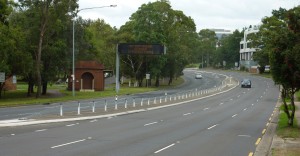
Concord Road, Rhodes. Nearby Homebush Bay Drive struggles to cope with traffic volumes because lane markings do not reflect road space available.
NorthConnex
The 6 Lane Pennant Hills Road in Peak Hour traffic flows quite well. Improving and expanding the Northern and North Shore Rail Lines and building new Heavy Rail Lines as contained in www.isput.com.au is better value for the taxpayer.
SouthConnex
Former New South Wales Labor Minister for Transport Carl Scully announced that the F6 Corridor would become a corridor for Railways instead of a Road. Mr. Scully also funded additional Track Capacity on the East Hills Line before the Kingsgrove-Revesby quadrupling project was announced or when the new tracks opened on 15 April 2013.
SouthConnex will only add to traffic congestion. Even when the Cronulla Railway Line was duplicated there were no plans announced to quadruple the Illawarra Railway Line between Sutherland-Hurstville.
EastConnex
Currently no plans have been announced for an EastConnex. However as sure as night follows day the roads lobby will dream up lines on a map in the same way that the County Road through Eastwood has been on road maps since the 1950s and land reserved. While the County Road land still remains reserved, land for a Northern Beaches Railway was sold off in the 1960s.
WestConnex
Previously Victor P Taffa worked as a Sydney Taxi Driver from Oct 2002-May 2007 and knows the vagaries of the road network only too well.
WestConnex should not involve resuming affected Residential Properties’ without compensating owners at Current Market Value Rates. WestConnex will not solve traffic congestion. The M2 Motorway was sold as the answer to traffic congestion and the final piece in the missing road network puzzle.
WestConnex will worsen congestion particularly on the City West Link. WestConnex will not be going near Southern Cross Drive and there are no plans to widen the M5 East. WestConnex will not be going to Sydney Airport.
Plans to widen current lanes or improve lane configuration on the M4 should be supported.
Opposing Case:
City West Link:
The City West Link cannot currently handle traffic let alone funnel more traffic onto it with the construction of WestConnex. The only alternative is to widen the City West Link and this requires the purchase of Homes.
Cross City Tunnel:
William Street used to be a 6 Lane Road. When the Cross City Tunnel was opened traffic was forced to use Cross City Tunnel and William Street was reduced to 1 Lane in either direction. There is no guarantee that Tunnel Funnelling will not occur with roads around WestConnex. The Cross City Tunnel has gone broke since opening to traffic.
Lane Cove Tunnel:
Epping Road used to be a 6 Lane Road. When the Lane Cove Tunnel was opened traffic was forced to use Lane Cove Tunnel and Epping Road was reduced to 1 Lane in either direction. There is no guarantee that Tunnel Funnelling will not occur with roads around WestConnex. The Lane Cove Tunnel has gone broke since opening to traffic.
Alternative Plans:
M4:
Traffic at the M4/Centenary Drive intersection should be heading south via a widened Centenary Drive or a new tunnel connected to the M5. This will shorten the link between the M4 and the M5 which is what the WestConnex project is intended upon doing.
King Georges Road:
King Georges Road at Beverly Hills is a 6 Lane Road. Beyond South Hurstville King Georges Road is a 6 Lane Road. The section of King Georges Road between Beverly Hills and South Hurstville is 4 Lanes and requires to be widened to 6 Lanes. The Land for the widening is set aside.
Victoria Road:
Between the area in the vicinity of the old White Bay Power Station and the old White Bay Hotel site a City Bound 3 Lane fly-over to connect seamlessly to the ANZAC Bridge for Victoria Road. The existing Bus Stop near the old White Bay Hotel site would be incorporated onto the new fly-over.
At present City Bound Traffic merges from 3 Lanes to 2 Lanes across the Goods Railway Bridge and goes back to 3 Lanes. This Fly-over would join seamlessly with the Anzac Bridge. In addition to Traffic Congestion caused by the Iron Cove Bridge Duplication the Victoria Road White Bay area is also Heavily Congested at all times of the day.
Pacific Highway:
Grafton:
The Pacific Highway at Grafton is in urgent need of duplication. On 20 October 1989 21 People were killed and 22 People were Injured in a horrific Bus Crash.
Kempsey:
The Pacific Highway at Kempsey is in urgent need of duplication. On 22 December 1989 35 People were killed and 41 People were Injured in a horrific Bus Crash.
The Pacific Highway between Newcastle and the Queensland Border similarly requires duplication.
The Pacific Highway Duplication Projects are more urgent and important than building WestConnex.
Heavy Railway Expansion:
Heavy Railway Expansion should occur in preference to Parramatta Road Light Rail.
Expanding our Railways is more an urgent and important problem to overcome than building WestConnex. This includes new Heavy Railway Lines, Line Duplication and Line Quadrupling. Electrifying every Railway Line throughout New South Wales is more an urgent and important problem to overcome than building WestConnex.
High Speed Rail is more an urgent and important problem to overcome than building WestConnex.
www.isput.com.au contains Heavy Railway Expansion Plans and is a better solution than WestConnex.
www.isput.com.au contains Heavy Railway Expansion Plans and is a better solution than Metro Rail.

 RSS feed
RSS feed 